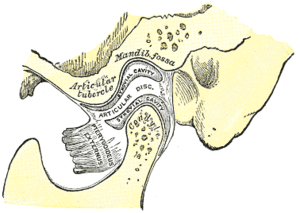Articular disk of the temporomandibular joint
| Articular disk of the temporomandibular joint | |
|---|---|
 Sagittal section of the articulation of the mandible (articular disk visible at center) | |
| Details | |
| Identifiers | |
| Latin | Discus articularis articulationis temporomandibularis |
| TA | A03.1.07.002 |
The articular disk is a thin, oval plate, which is made from fibrous connective tissue, non vascular, placed between the condyle of the mandible and the mandibular fossa.
Its upper surface is concavo-convex from before backward, to accommodate itself to the form of the mandibular fossa and the articular tubercle.
Its under surface, in contact with the condyle, is concave.
Its circumference is connected to the articular capsule; and in front to the tendon of the Pterygoideus externus.
It is thicker at its periphery, especially behind, than at its center.
The fibers of which it is composed have a concentric arrangement, more apparent at the circumference than at the center.
It divides the joint into two cavities, each of which is furnished with a synovial membrane.
See also
References
This article incorporates text in the public domain from the 20th edition of Gray's Anatomy (1918)